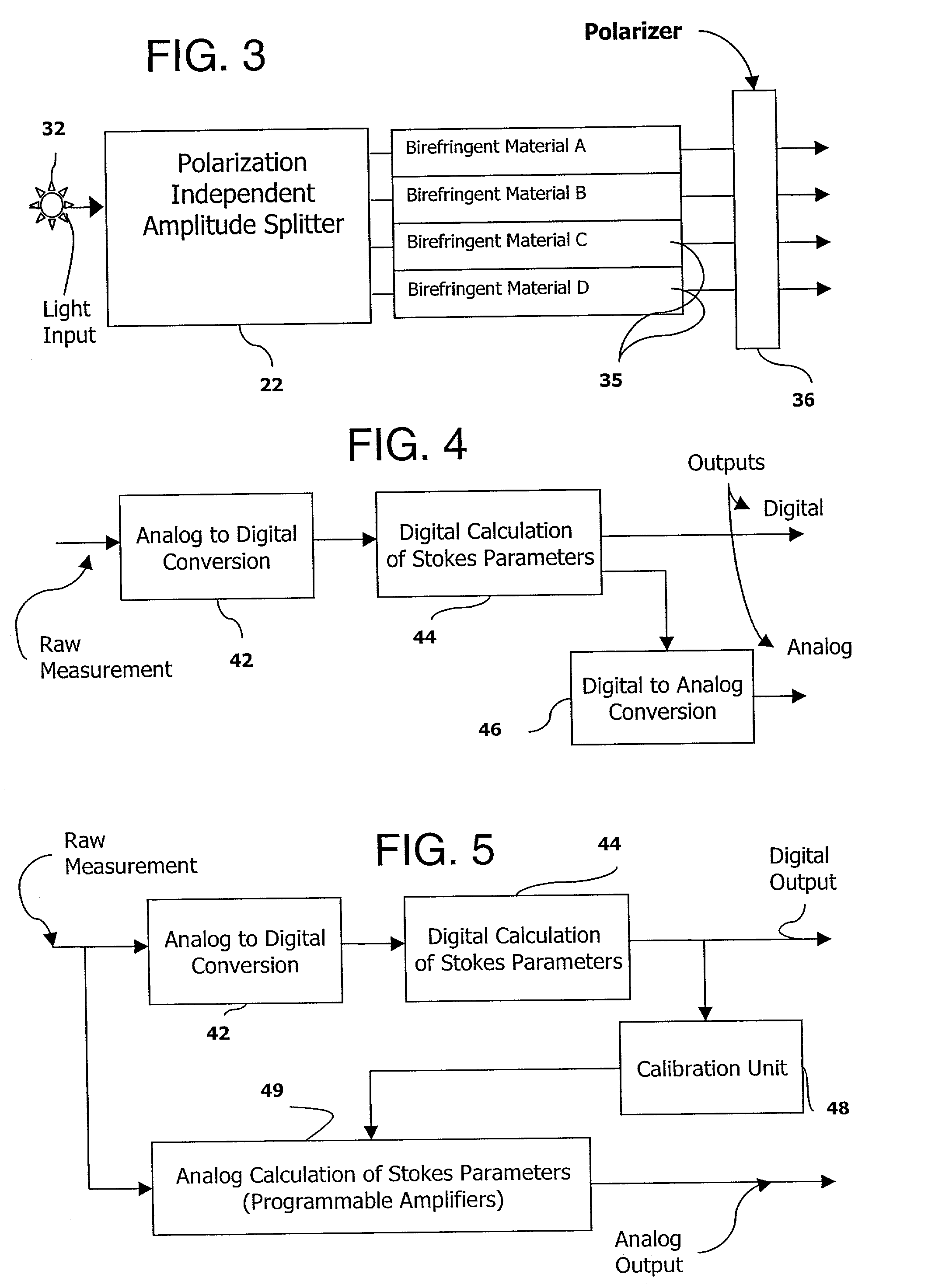It may be difficult or impossible to determine the polarization state of a
wideband signal, although it may be possible to sample by taking a number of polarization analysis unit readings at different substantially-
monochrome wavelengths or different time segments.
Small differences in relative position and orientation of components can complicate the problem of measuring polarization parameters.
One challenge is to determine accurately what the matrix factors should be.
Calibrating by accurately choosing a matrix of inter-
related factors can be a complicated problem.
However, this is not always practical because of the requirement for the accurate standard of reference, in this case accurate information defining the polarization state of the input reference signal.
However, there is a larger and much more complicated problem involved in calibrating a
polarimeter or a polarization analysis unit, namely the extent to which raw measurements taken for each of the four or more raw measurement channels contribute to the Stokes measurement values that are needed at the output.
The geometry needed, particularly to obtain high accuracy measurements using a specific set of reflection angles, does not lead readily to a compact size.
Because of the complex relation and limited tunability between the incident angle and the polarization response, the structure is difficult to optimize to achieve the optimum performance.
In addition, the accuracy of this device is not optimized and appears difficult to optimize.
The polarization dependence of this type of splitting is not highly discriminating, which affects the resulting measurement accuracy.
Polarizers included at various angles to each of the beams can improve accuracy, but are not wholly optimal because of the non-optimized configuration.
The large number of beams in such a device permits a varied set of measurement operations, but is arguably redundant and inefficient.
The device also is somewhat impractical because a low dispersion
grating is needed to generate sixteen beams, and a rather long diverging distance is needed for the beam separation to provide enough space to admit polarizers and intensity responsive photodetectors for each separate beam, rendering the overall device rather large.
The polarized plus one
waveplate, although commonly used in many polarization measurement setups, is not an optimized configuration.
The challenges in the design and configuration of a polarization analysis unit include high speed, high accuracy, high efficiency and compact size.
It is a substantial challenge to achieve all these attributes at once.
There are other complexities of concern, such as
processing requirements and calibration needs, among others.
Polarization analysis units based upon single mode
fiber designs are, in principle, unable to make such a measurement.
The optical sensor has a limited operation range.
If the input
light signal is too strong, the sensor will be saturated.
Accuracy is a serious issue for polarimetric measurements since small changes in the optical measurement head (e.g. due to environmental conditions such as temperature) can lead to large errors in the measurement of the polarization state.
High accuracy computations in analog may not only consume time but may require additional expense for components and may bring about further calibration and accuracy issues.
The speed of the measurement is generally limited fundamentally by the
response time of these photodetectors, because in a division of amplitude configuration, other requirements are at least as fast or need not be accomplished in real
time sequence with collection of the data values needed to resolve the output data from the measured input values.
A single calibration reference signal may not exercise all the measurement signal paths that are employed to
encode a polarization state, or may not permit errors to be isolated, for example, to specific measurement signal paths or scaling factors.
However, a difficulty is presented in precisely creating the several distinct states.
Precisely, the difficulty lies in obtaining standard sources of polarized
radiation.
If one assumes that a source is accurate at one time, there is still a potential problem that drifts with time and temperature may require calibration of the reference
signal source.
Furthermore, calibration errors in the polarization analysis unit can affect pairs or groups of values in the device matrix defining the response of the polarization analysis unit.
This limit determines the accuracy of the calibration.
There may be a complex interaction between the measurement
raw data values and the best adjustment factors in the 4.times.3
polarization dependent part of the device matrix.
More measurements are possible, but insofar as any redundant measurements are effected, the same optimization constraints affect all the redundancies.
If few measurements are required to determine the
Stokes parameters, the complexity of the device is low, at the possible cost of accuracy.
It is not possible in this way to obtain optimum performance from the
polarizer, because the four values B1 to B4 as shown, are not placed optimally far apart on the sphere.
Actually, it is not even possible to resolve all the
Stokes parameters using this method alone, because the volume of the instrument matrix is always zero.
Such an over-defined
system may produce better accuracy due to greater variation but has more complexity and may be more difficult to optimize.
 Login to View More
Login to View More  Login to View More
Login to View More 


